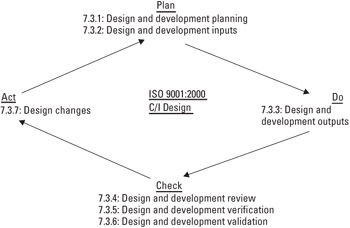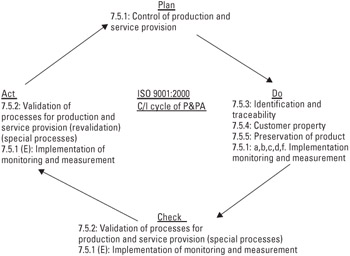3.2 Continuous Improvement Cycle Within Elements
|
3.2 Continuous Improvement Cycle Within Elements
3.2.1 Other C/I
The continuous improvement cycle can also be demonstrated in specific sections of the Standard (e.g., Section 7.3: Design and Development, as shown in Figure 3.2).

Figure 3.2: Section 7.3— Design and Development— continuous improvement cycle.
3.2.2 Further Demonstration
We can also demonstrate that Section 7.5: Production and Service Provision (P&SP)—as illustrated in Figure 3.3—also contains a continuous improvement cycle.

Figure 3.3: Section 7.5— Production and Service Provision.
3.2.3 Continuous Improvement Cycle
This phenomenon is a general trend throughout the Standard as demonstrated further in Table 3.2. This table is not meant to be inclusive, but illustrates the general trend. The interested reader, who delves deeply into the ISO well, will find even more clauses that fit the cycle.
| ISO 9001:2000 Element | Plan→ | Do→ | Check/Study→ | Act→ |
|---|---|---|---|---|
| 7.4 Purchasing | Establish criteria to evaluate and select suppliers. | Select suppliers and prepare purchasing information. | Ensure adequacy of specified purchase requirements and maintain records. Implement the inspection or other activities. | Evaluate and reevaluate suppliers. |
| 8.5.2 Corrective Action | Document procedure to define requirements. | Review nonconformities (including customer complaints); determine the causes. | Evaluate the need for action; determine action needed. Review corrective actions taken. | Implement actions needed and record the results of actions taken. |
| 8.2.2 Internal Audit | Planned program at planned intervals and planned arrangements. Define audit criteria, scope, frequency, and methods. Create documented procedure. | Conduct internal audits based on status and importance of the processes and areas to be audited. Maintain records. Effectively implement and maintain QMS. | The management responsible for the area ensures that actions are taken without undue delay to eliminate detected nonconformities. | Follow-up activities to include the verification of actions taken and the reporting of verification results. |
3.2.4 Continual Improvement Imperative
We conclude that both a market orientation and the continuous improvement cycle is inherent within the Standard—whether you wish it or not—and as a result it is necessary to respond to every requirement to ensure that the Standard's continual improvement integrity is maintained.
|
EAN: 2147483647
Pages: 155